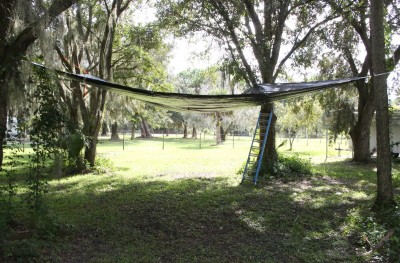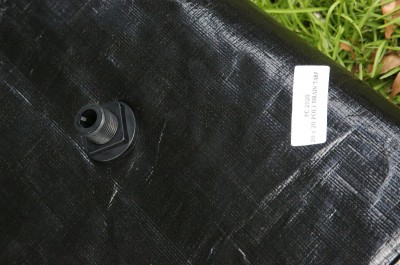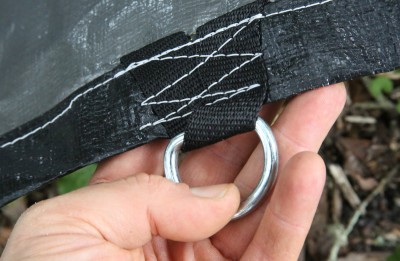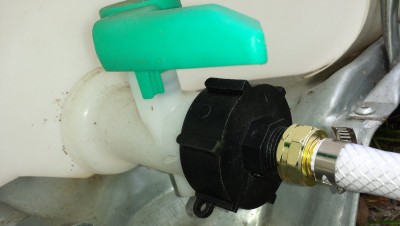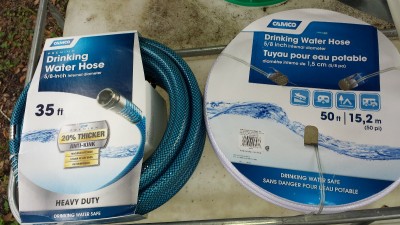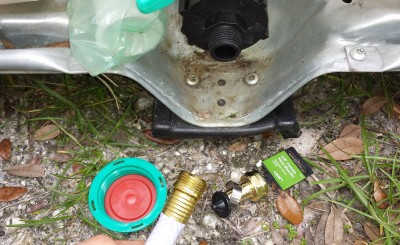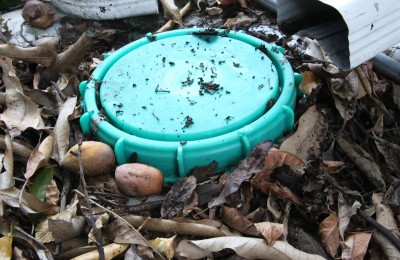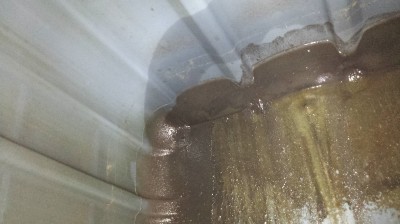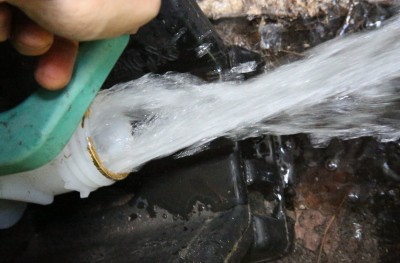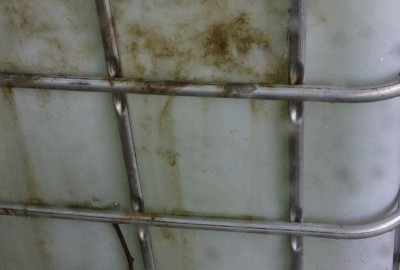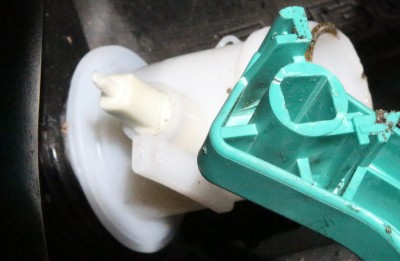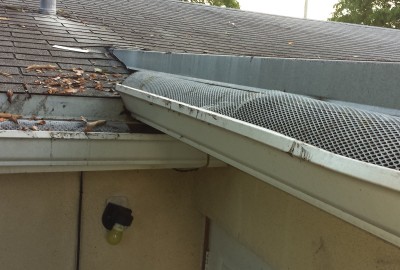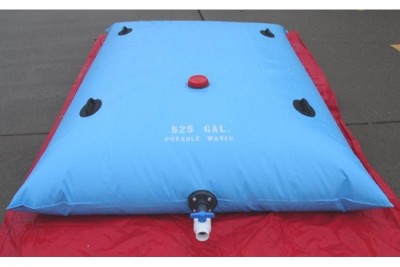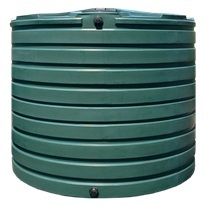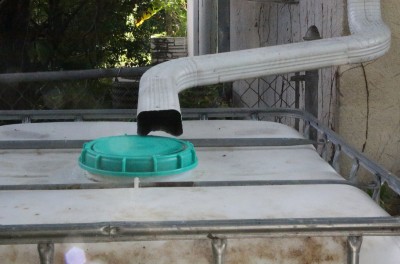
This is my rudimentary rainwater collection system. I put gutters on my house, and the downspout empties directly into an IBC tote.
I like to share my failures with you all along with my successes, and I have to to tell you, water, the most important resource of all, is a tough thing to collect and store successfully. I set up my own collection system over a year ago, when I first started this column in March of 2014, and water was my very first actual article. For me, the most bang for the buck was to buy some used IBC totes, which I showed you in that article. Then I had gutters installed on my house, with the downspouts directly feeding into the tanks. The result was a lot of water, but a year and a half later, it’s not as simple. I also tried an alternate water collection system, as I’ll explain, and that is still giving me fits.
|
var enterTextHeret4f33t11=’in³’;var resultTextHintt4f33t11= ‘US gal lqd’;var convertTitleTextt4f33t11= “in³ to US gal lqd”;var timeStringt4f33t11;var decimalPlacest4f33t11;var dt4f33t11 = new Date(0);var freeText251=’Last updated: ‘;function initConvertt4f33t11(){$(‘#argumentt4f33t11’).attr(‘placeholder’,enterTextHeret4f33t11); |
|---|
| Put your total square inches into the top box. For example, a 50 x 50 roof (600 inches by 600 inches) would be 360,000 square inches. It becomes cubic inches with one inch of rain (x 1). |
To calculate how much water you can collect from the roof of your house, measure the outside dimensions of the roof. Because there is pitch to the roof, the square inches of the panels themselves are irrelevant. If it rains one inch, that means that straight down, if you have a one inch by one inch collector, it will be one inch full. So if your roof measurements are 50 feet by 50 feet, for simplicity, that’s 360,000 square inches. If you collect all of the water that falls, that adds up to 1,558 gallons per inch of rain. Look up the average rainfall for your area, and you’ll be able to figure out just how much water you can store over the course of a year. Phoenix Arizona gets just over 8 inches of rain over 30 days per year. Miami gets about 62 inches over 135 days. Therefore for me, I could conceivably collect 96,596 gallons of water per year.
The trick is, most places have rainy seasons and dry seasons, and during the rainy season there is no way you can collect and store all of that water, unless you have built a proper cistern. If you have no water at all in your area, a proper cistern might be as much as 2 or 3 gallons per day per person in between the longest dry stretch of no rain. According to the WHO, in a PDF you can download about survival water, the minimum water you need to drink is 2.5 liters per day on average. Call it a half gallon. So if you have 4 people, and it goes 4 months without raining, that works out to 60 gallons per person, or 240 gallons. One IBC tote, which I promise you that you can find locally for $250 or less, holds 275 gallons. That gives you a little bit for sponge baths too, and brush your teeth until the toothpaste runs out for heavens sake ok.

Most prepping and survival blogs claim that you need 2 gallons or more per person per day, but the WHO says that it is much less than that for just water to drink.
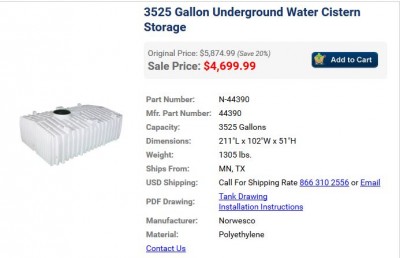
Plastic Mart has tanks that will fit through your apartment door that hold several hundred gallons, right up to this almost 4,000 gallon tank to bury in the back yard. If you have a lot of people, even 30 inches of rain in your area could provide plenty of water from your roof, if you have a way to hold it all with a couple of these tanks.
In my first article I linked to Plastic Mart, and they sell tanks of all sizes, including large tanks that fit through the door of an apartment, and even huge multi-thousand gallon tanks designed to be buried specifically as a cistern. Even though rainwater is filled with nanoparticles of aluminum these days from the aerosol spraying of our atmosphere, as we are being sprayed like insects, rainwater is clean, and you can live on it without concern for parasites, cysts, harmful bacteria, or chemicals above the nanometer size.
If you don’t use your water, that is where the problems arise. Like you, I’m waaaaay too busy with life responsibilities these days. For maybe three months I reliably put a tablespoon of pool shock into my water containers once a month, then closed them up tight. At some point, I procrastinated it, then I saw that algae was growing and that I should empty them and clean the tanks and start over again. A year and a half later, that wasn’t so easy. The algae by now was really heavy, so I had to pressure wash the entire inside of the tanks, then wipe out the insides with a towel and a broomhandle. Then, well let me back up. I also never finished putting my gutter guards on the gutters, soooo, turns out there is two inches of compost in the entire gutter system that first needed to get cleaned out. Several hours on a ladder later, I am now ready for it to rain again, twice, because I need to let the dirty water in the gutters run out first. I’m actually going to just fill one of the tanks with city water for now, just so I know I have some backup.
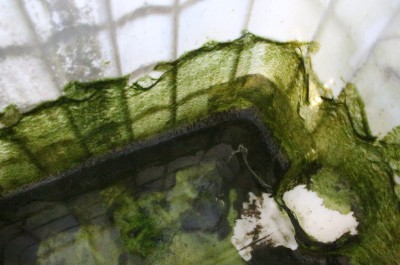
This is the mess that was inside my water tank after a year and a half of neglect. I suspect the water wouldn’t have tasted great, but no, I didn’t taste it. Other than the algae it was crystal clear, and still better than having to leave to try to get some water.
What a mess! In the first article I had warned against relying on your swimming pool for drinking water. Because besides the chemicals that most pool service companies add to the chlorine, without regular chlorine any pool will turn green. Now granted, the water in the buckets was still free of all the bad stuff. A year and a half later it would probably have a stale taste to it, but you could live on it. And most importantly, you don’t have to leave your home to go somewhere to drag it back, exposing yourself.
After I refill the tanks I am painting the white ones black. The one black tank I was able to get from my local source had far less algae in it, which makes sense because algae needs sunlight to grow. You could do the same thing by putting a tarp over your tanks, but the UV here in Florida destroys tarps in about a month.
Adding Cubic Inches, or… “How to Hide a Water Collection System in the Trees”
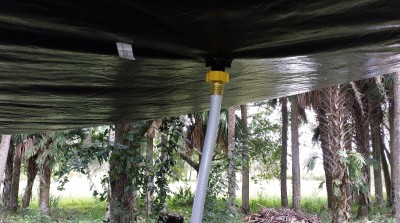
A drain tarp has a built in spigot for the water to escape. Generally they are threaded for a garden hose.
It is hard to boil life down to a numbers game, but unfortunately that is what survival entails. There are times during the dry season that it rains. Sometimes it’s an inch of rain, sometimes a half inch, sometimes a couple inches. Because our weather is now completely geoengineered, rain is really a crapshoot no matter where you live. We have had a new phenomenon of dry ground strike lightning here in Florida, but at least someone paid enough to keep the hurricanes away since 2005.
To capture every square inch of rain, you may want to think about investing in some “drain tarps.” The best place I have found is Global Industrial, but you can Google it and you’ll see a lot of options (which may all be affiliate sites for them actually). There are even some on Amazon, but they don’t seem to be cheaper for what you get than Global Industrial either. They come in various thicknesses and sizes, and all of them have a hole and spigot built into them. The spigot is threaded for a garden hose. Of course you can also make your own with common parts from Home Depot, but I have looked around and it doesn’t look like you save anything. You get what you pay for with tarps.
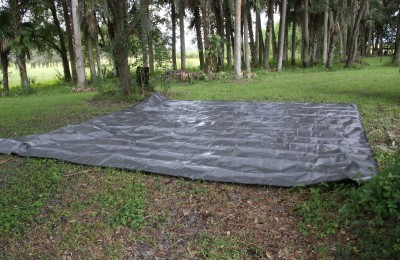
It was not as easy as I thought to find four trees that were square enough to each other to tie up the four corners. I chose the 20×20 size figuring that it would be easy, but it was not.
Even a 7 x 7 tarp gets you 30 extra gallons of water per inch of rain. I bought 20 x 20 size, but them come up to 30 x 30. A 20 x 20 is 57,600 square inches, which equals 249 gallons per inch of rain. That fills a whole IBC tote almost! I also found a 30 x 50 on another site for $499. That’s like 216,000 square inches, and almost 1,000 gallons per inch of rain, which is a lot.
Getting the rain to actually go into the tote is a whole other ordeal, and one I have not entirely conquered, but I’m still working on it. I bought the heavy duty tarp with the sewn in D rings for the sides and corners, figuring that I would find 4 trees that are fairly square to each other and tie off the corners. What I didn’t realize was that these tarps are made to catch leaks in ceilings, so the entire concept of a reliable drain tarp somewhat depends on level and square corners. Tied to trees and tree branches, getting them the same height and square, for me, was nearly impossible.
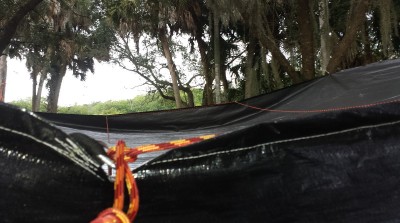
I found it nearly impossible without perfectly square mounting points to get the tarp to work properly, so I threaded the D rings with a rope to pull two edges up. It works now.
My answer was to thread the middle D rings with a rope, and pull the edges of the tarp up, to make a bowl. That has worked, but it took a few tries, where the water just spilled on the ground. Tying the edges up does reduce your square inches of course, but you have to do what you have to do.
Here I also should note that in some parts of the country, it is already unlawful to collect rainwater for your own use. I haven’t looked into specifically where this is, but if you are in one of those areas, probably in the West, you know it. Collectivism is only going to get worse as the situation gets worse, and don’t think that the collapse has to come in with a bang. We are already currently sliding into the collapse. Workforce participation rate is at an all time low, and the Fed is out of bullets to try to keep their stock market and real estate bubbles alive. It could gradually just get worse and worse so that collectivism puts the people at the 100% mercy of the government. Hiding your water collection, or at least having the option to, is probably a good idea. I got black tarps, not white ones. And now that this article is out, I’m going to nicely fold my tarp back up and put it away.
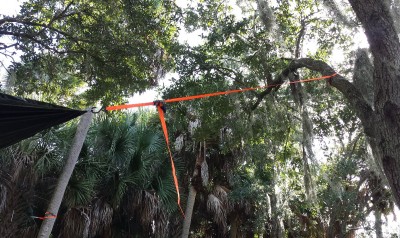
I also couldn’t tie the corners off to the same height, so I had to guess at level. You can’t tie the tarp square tight or it won’t have a depression for the water, so it really is trial by error.
If anything, my experiences here with water should teach you a lesson that you have to learn and test your survival systems today, before you need them. Don’t just assume that because it makes sense it’ll work. In South Florida there is a ton of water. I can dig a hole in the my backyard, then filter it with my JustWater filters. You may not have that ability, and if you are on city water especially it would be a good time to devise a backup plan. Nobody can live without water for more than a few days, and it isn’t going to be a nice environment outside if you have to go gather it elsewhere. One thing I can tell you, the FEMA truck ain’t coming for the big one. I hope that day never comes, but it probably will, and it could be soon.
To Be Continued!
Water is such an important priority for all of us, but it is very detailed. I just discovered large bladder tanks from a supplier called “Fol-da-tank.” If you need to be covert, like if you live in Colorado, these tanks could be hidden in your home, and I need to put some effort into moving water around with 12v systems. There are also a lot of really nice high end tanks for rainwater collection at Tanks for Less, which is where I found the big bladder tanks. The important thing is to get going.
